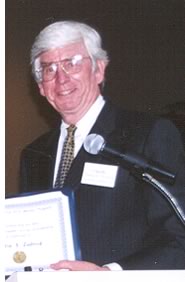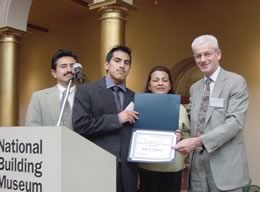
by Thomas J. Storrs, AIA, and F. Hamilton O'Dunne, AIA
 The
ACE Mentor Program (ACE stands for architecture, construction, and engineering)
began in New York City in 1994. Design and construction firms working
together teach high school students what it is like to work in each of
their disciplines. In 1995, the firm principals who founded ACE established
a scholarship fund as well to help outstanding graduates from the ACE
course with their college tuition.
The
ACE Mentor Program (ACE stands for architecture, construction, and engineering)
began in New York City in 1994. Design and construction firms working
together teach high school students what it is like to work in each of
their disciplines. In 1995, the firm principals who founded ACE established
a scholarship fund as well to help outstanding graduates from the ACE
course with their college tuition.
Charles H. Thornton, of Thornton-Tomasetti Engineers, one of the cofounders, got HNTB and a number of other firms here interested in forming a chapter in Washington, D.C., a couple of years ago. He called saying we had to get involved with this fantastic program to draw bright high school students into the building professions. The two of us decided to participate as a team to make the time commitment more practical. We've also involved other younger architects here in the office.
 The
reason the concept appealed to us was that we thought we could do more
as architects to reach out to kids, particularly in the inner city. It
sounds like a cliché, but it's a way to give something back. It
hasn't been without its challenges. But it's been extremely rewarding
to work with these kids and see the interest on their faces.
The
reason the concept appealed to us was that we thought we could do more
as architects to reach out to kids, particularly in the inner city. It
sounds like a cliché, but it's a way to give something back. It
hasn't been without its challenges. But it's been extremely rewarding
to work with these kids and see the interest on their faces.
We developed a nine-month curriculum, the same schedule as the school year, and each week we do something different. We tried to come up with a program that was indicative of what our professional day is like, whether it was looking at six different projects in the two-hour weekly session or showing a time-lapse design-construction video. We tried to give them a realistic taste of being an architect.
The presentations move around among different offices. We had a lot of the sessions here in our office because we are close to mass transit and it was convenient for the kids. We would also take them to the structural and mechanical engineers' offices as well as actual construction sites.
Get involved
Why would other architects want to do this? If you have the least bit
of interest in what it's like to teach architecture, we would encourage
you strongly to get involved.
There is, of course, a commitment of time. It isn't huge, probably three to four hours a week. It's true that in our busy schedules that can be a lot of time, but you just make a commitment and do it.
One of the more interesting aspects of participating in the ACE program is that you have fun. You're giving young people a flavor of the whole process of design and construction. You're not trying to teach them to be architects in nine months, naturally, just giving them an understanding and appreciation of why we find our jobs interesting. So you can have some fun. And the kids have fun learning about buildings and how they are built. At the beginning we saw some of the students with muted interest at best. And by the end of the nine months, these kids are really into it.
The challenges
One of the challenges is that out of your whole audience, only a portion
are interested directly in architecture, as opposed to construction or
engineering. So we found it important to diversify the agenda. Personally,
we think we were successful in showing the students a tremendous amount,
much more than they would have picked up in a classroom setting.
 Another
challenge is in instilling in the students a drive to learn. And that
can be hard because of the different levels of interest and the fact that
we didn't always get the exact same people attending from week to week.
Another
challenge is in instilling in the students a drive to learn. And that
can be hard because of the different levels of interest and the fact that
we didn't always get the exact same people attending from week to week.
We expected that the scholarships would be an incentive. They are $2,000 or $3,000 and awarded at the end of the year to the most worthy students. The Washington, D.C., ACE chapter was able to give five students scholarship funds last May. Sometimes, though, we were surprised that the students didn't vie more vigorously for that scholarship money.
The rewards
We have heard some great success stories from other ACE mentors in which
the students have come back as interns for the summer while they're in
college. We even heard that some ACE-program alumni have eventually come
back after they've graduated as full-time employees of their mentor firms.
In our experience, we've already seen success stories where kids got into university architecture programs. In one case, a young man and his younger brother both got scholarships through our ACE chapter. One is going to the Catholic University of America and the other to the University of Maryland.
The side benefits
Another benefit of participating in this program is that it puts you in
contact with other professionals in the industry, including constructors,
engineers, and real-estate developers too. We even formed business relationships
with two construction firms that have already developed into working partnerships
on some building projects.
And even after having been in this business for 20-plus years, both of us have learned things during these seminars. When we bring our engineers in to give conceptual overviews on mechanical systems or structures, we actually learn some things too. Because the curriculum we develop is broad-based through the industry, you get good cross-communication among architects, engineers, and constructors. And from that you get fresh insight.
Copyright 2002 The American Institute of Architects. All rights reserved.
![]()
|
For more information about the ACE program and getting involved, visit the ACE Web site. The authors work for HNTB Architecture, Washington, D.C. Hamilton O'Dunne is director of higher education architecture. Tom Storrs is a design principal. Photos by Neil Sandler, NIBS. |
|